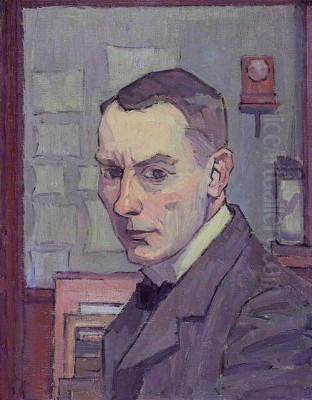
Robert Polhill Bevan stands as a significant figure in the landscape of early 20th-century British art. Born in 1865 and passing away in 1925, Bevan was a painter, draughtsman, and lithographer whose career navigated the exciting transition from Victorian sensibilities towards European Modernism. He is perhaps best remembered as a founding member of the influential Camden Town Group, an association that places him firmly within the narrative of British Post-Impressionism. His distinctive style, often characterized by angular forms, a bright palette, and a focus on specific subjects like horse markets and London scenes, marks him as an artist who absorbed continental innovations while retaining a uniquely British perspective.
Early Life and Artistic Formation
Robert Polhill Bevan was born into a comfortable background on August 5, 1865, in Brunswick Square, Hove, near Brighton in East Sussex. He was the fourth of six children of Richard Alexander Bevan, a partner in the Barclays Bank predecessor, Bevan & Co. While his family might have envisioned a more conventional path for him, potentially involving Oxford University, young Robert harboured artistic ambitions from an early age. His formal art education began at the Westminster School of Art in London under the tutelage of Frederick Brown.
Following his time at Westminster, Bevan, like many aspiring artists of his generation, sought further training and exposure on the continent. In 1888, he continued his studies in London before making the pivotal decision to travel abroad. This period included time spent in Spain and Morocco with fellow artists Joseph Crawhall III and George Denholm Armour, experiences which likely broadened his visual horizons, exposing him to different light conditions and cultural motifs, although his most formative experiences abroad were yet to come in France.
Immersion in French Modernism: Pont-Aven and Paris
The early 1890s were crucial for Bevan's artistic development. He travelled to Brittany, specifically to the artists' colony of Pont-Aven. This was a melting pot of artistic experimentation, famously associated with Paul Gauguin. Bevan spent time there between 1890 and 1894, overlapping with Gauguin and his circle. During this period, he absorbed the principles of Synthetism, characterized by bold outlines, flattened forms, and expressive, non-naturalistic colour, although his own interpretation would remain distinct.
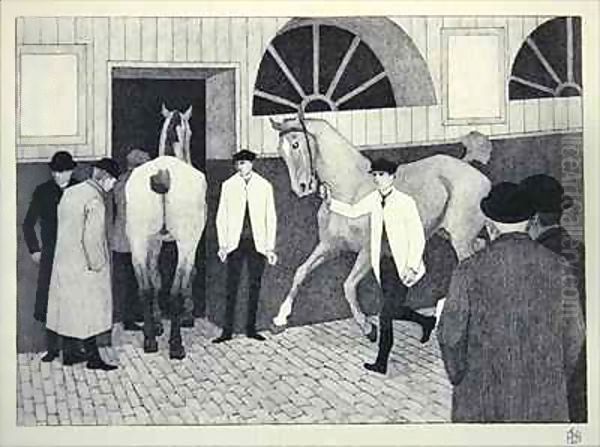
His time in France also included periods studying at the Académie Julian in Paris, a popular destination for foreign art students. Critically, he encountered the works of major Post-Impressionist masters. The structured compositions and analytical approach of Paul Cézanne, the vibrant colour and emotional intensity of Vincent van Gogh, and potentially the atmospheric works of Pierre-Auguste Renoir (whom he may have met), all left their mark. Bevan experimented with Divisionist techniques, using small dabs of pure colour, evident in some of his Breton landscapes, aiming for optical vibrancy.
This immersion in French avant-garde art fundamentally shaped Bevan's approach. He returned to England equipped with a new visual language, one that prioritized bold colour harmonies, simplified drawing, and a structured sense of design over academic naturalism. This set him apart from many of his British contemporaries and laid the groundwork for his later contributions to modern art in Britain.
Return to England: Forging a Mature Style
Upon returning to England permanently around the turn of the century, Bevan settled initially in Exmoor before moving to London in 1900. He established a studio in the St John's Wood area, later moving near Cumberland Market, a location that would feature prominently in his work. His style continued to evolve, moving away from the stricter pointillism of his French experiments towards a broader, more angular application of paint, often using flat planes of colour defined by strong outlines.
His subject matter began to coalesce around specific themes that would define his career. The urban landscape of London, particularly its less glamorous aspects like mews, cab yards, and street scenes, became a recurring motif. He was particularly drawn to horses, not in the aristocratic tradition of sporting art, but as working animals within the city – cab horses, market horses, horses at auction. His depictions often possessed a stark honesty, focusing on form and structure rather than sentimental narrative.
Bevan's palette remained bright, influenced by his Post-Impressionist experiences, but adapted to the specific light and atmosphere of England. He developed a distinctive way of simplifying complex scenes into bold, almost geometric patterns, emphasizing the underlying structure and design. This approach, while rooted in French modernism, was applied to quintessentially English subjects, creating a unique artistic identity.
The Camden Town Group: A Collective Vision
Bevan's role as a founding member of the Camden Town Group in 1911 cemented his place in British art history. This short-lived but highly influential group brought together artists who shared an interest in depicting contemporary urban life using modernist techniques derived largely from French Post-Impressionism. Key figures alongside Bevan included Walter Sickert, Spencer Gore, Harold Gilman, Charles Ginner, and Lucien Pissarro (son of the Impressionist Camille Pissarro).
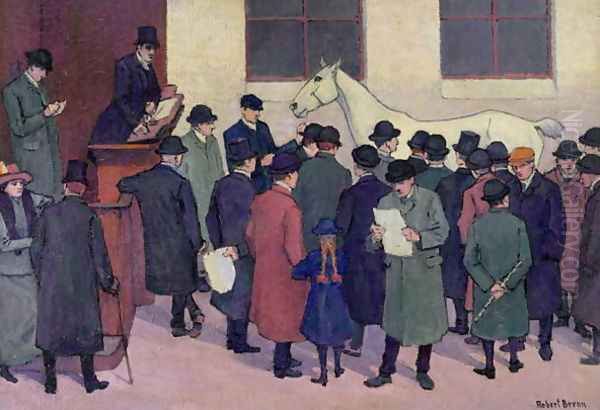
The group held only three exhibitions (in 1911 and 1912) but represented a significant force for modernism in the relatively conservative London art world. They focused on scenes of everyday life – interiors, streetscapes, portraits – often rendered with bold colours and simplified forms. Bevan's contributions often featured his characteristic London scenes and horse subjects, fitting well with the group's ethos. His more structured, angular style contrasted somewhat with Sickert's tonal approach but shared the commitment to modern subject matter and technique.
Although the Camden Town Group itself was brief, its impact was considerable. It helped to popularize Post-Impressionist ideas in Britain and paved the way for subsequent modernist movements. Bevan's involvement underscores his commitment to collaborative artistic endeavours and his position at the forefront of progressive art in Edwardian England. Artists loosely associated or exhibiting with the group, like Augustus John, further highlight the vibrant network Bevan was part of.
Other Artistic Affiliations: London Group and Cumberland Market
Bevan's engagement with artistic groups extended beyond Camden Town. When the Camden Town Group merged into the larger and more diverse London Group in 1913, Bevan became a founding member of this new entity as well. The London Group provided a broader platform for exhibiting modern art, encompassing a wider range of styles, including artists moving towards abstraction like Wyndham Lewis (though Lewis soon broke away to form the Vorticists) and Christopher R.W. Nevinson. Bevan remained involved, exhibiting regularly.
Later, around 1914-15, Bevan formed the Cumberland Market Group with fellow Camden Town and London Group artists Harold Gilman and Charles Ginner. This smaller group focused more specifically on their shared neighbourhood and artistic interests, holding exhibitions in their own studios near Cumberland Market in North London. This initiative reflects Bevan's ongoing commitment to exhibiting work outside the established gallery system and his close working relationships with Gilman and Ginner, artists who similarly embraced bold colour and form in depicting urban reality.
Key Themes: Horses, London, and Landscapes
Bevan's oeuvre is strongly identified with several recurring themes. His fascination with horses is perhaps the most distinctive. He frequented London's horse markets, particularly Tattersalls and the Barbican, sketching the dealers, the buyers, and the animals themselves. His paintings and lithographs of these scenes are not merely descriptive; they capture the energy, the forms, and the specific atmosphere of these environments. He treated the horses with a certain objective dignity, focusing on their structure and presence within the urban setting.
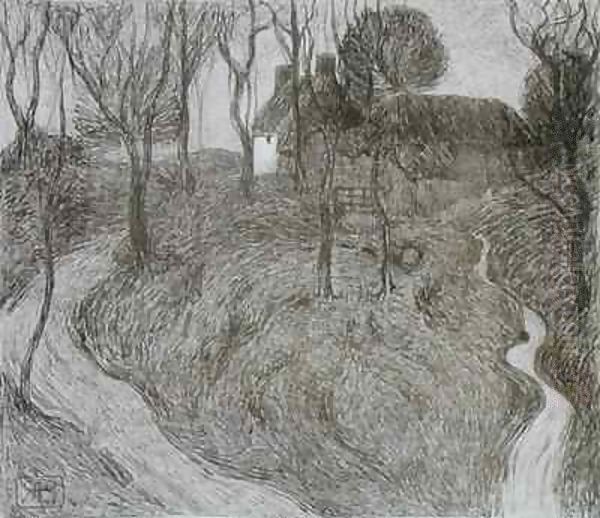
His London scenes extended beyond the horse markets to encompass the city's architecture and street life. He painted mews, squares, and cab yards, often favouring compositions with strong geometric elements derived from buildings, walls, and roads. These works capture a particular aspect of early 20th-century London, rendered in his characteristic simplified style and bright, sometimes unconventional, colour schemes.
While known for urban and equine subjects, Bevan was also a capable landscape painter. His early work included scenes from Brittany. Later, he painted landscapes during holidays spent in Devon, Sussex (particularly around the Blackdown Hills where he had a cottage), and Poland, the homeland of his wife. These landscapes often display the same stylistic traits as his urban scenes – simplification of form, strong outlines, and an emphasis on pattern and colour harmony, adapted to rural settings.
Notable Works: Capturing Form and Colour
Several works stand out as representative of Bevan's artistic achievements. The Cab Horse (c. 1910), now in the Tate collection, is an iconic example of his equine subjects. It depicts a hansom cab with its horse and driver, rendered in bold, angular shapes and flat planes of colour. The composition is stark and unsentimental, focusing on the formal qualities of the scene and the interplay of shapes. It was exhibited at the Royal Society of British Artists in 1910.
The Horse Mart, Barbican exists in several versions, including paintings and studies. These works capture the bustling atmosphere of the horse market, with simplified figures of men and horses arranged in dynamic compositions. A study from around 1918 is held at the Yale Center for British Art. A finished painting titled The Horse Mart achieved a significant price at auction in 1992, indicating continued appreciation for this theme.
Under the Hammer (1914) depicts a horse auction, likely at Tattersalls. Again, Bevan uses simplified forms and strong colours to convey the scene's energy and structure. The focus is less on individual detail and more on the overall pattern and rhythm of the composition, showcasing his mature style.
Other significant works include early landscapes like Hawkridge (1900), also held by the Tate, which shows his engagement with landscape painting upon his return to England, and later works like Fields at Applehayes (c. 1922), demonstrating his continued application of his style to rural scenes in Devon. His self-portraits, such as one included in the book The Victorians, offer insight into his persona.
Bevan the Lithographer
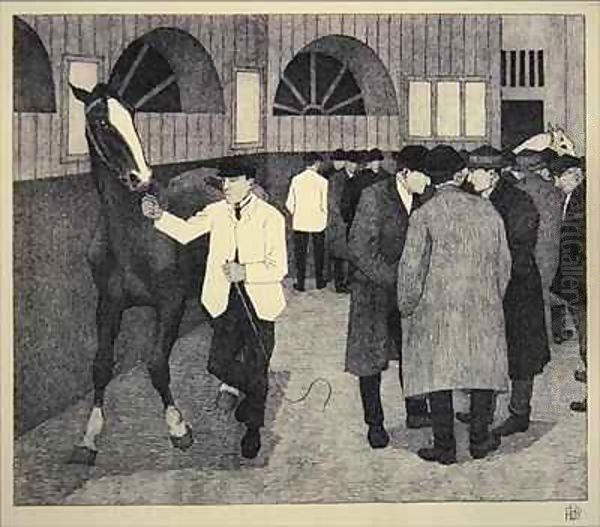
Beyond painting, Robert Polhill Bevan made important contributions as a lithographer. He embraced the medium relatively late in his career but produced a significant body of work, particularly during and after the First World War. Lithography suited his bold drawing style and interest in strong tonal contrasts.
His most celebrated works in this medium are the prints associated with the Cumberland Market Group and his fascination with horse markets. The series Barbican Horse Dealers, published in 1921, is a prime example. These lithographs translate his observational sketches of the market into powerful, simplified black-and-white compositions, capturing the forms and movements of the horses and dealers with characteristic angularity and vigour. His lithographs were exhibited alongside his paintings and further demonstrate his commitment to exploring modern subjects through varied techniques.
Personal Life: Family and Travels
In 1897, during one of his visits to Pont-Aven, Bevan met the Polish artist Stanisława de Karłowska. They married in Warsaw later that year. Stanisława was a talented painter in her own right, exhibiting alongside Bevan and with groups like the London Group. Her own work often featured vibrant colours and Polish folk motifs. Their marriage brought a strong Polish connection into Bevan's life.
The couple had two children: a daughter, Edith Halina (known as Halina), born in 1898, and a son, Robert Alexander (known as Bobby), born in 1901. The family divided their time between London and Poland, frequently spending summers near Kraków at the de Karłowska family estate. These Polish sojourns provided Bevan with fresh landscape subjects, distinct from his English scenes.
Bevan established his family home and studio at 14 Adamson Road in Swiss Cottage, London, in 1900, which remained his base for the rest of his life. He also acquired a cottage, 'Marisco', in the Blackdown Hills on the Devon-Somerset border, allowing him to pursue landscape painting more intensely during holidays. He continued working until his death from stomach cancer on July 8, 1925, at the age of 60.
Exhibitions, Collections, and Recognition
Throughout his career, Bevan exhibited his work regularly, though commercial success was often modest during his lifetime. He showed with the Allied Artists Association, the New English Art Club, and, significantly, with the Camden Town Group, the London Group, and the Cumberland Market Group. Posthumous exhibitions helped to solidify his reputation. His work The Cab Horse was shown not only in London but also travelled to an exhibition in Boston in 1926.
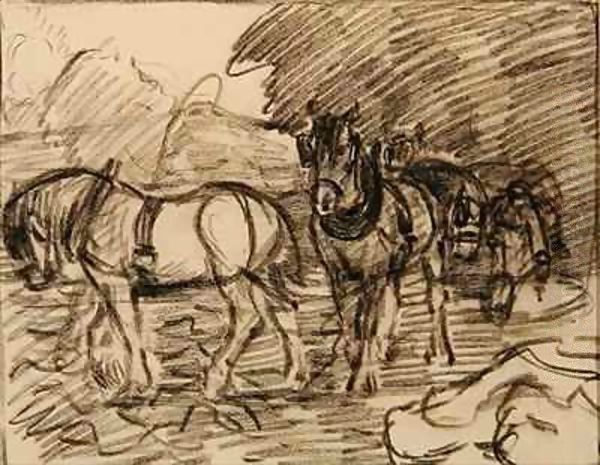
Today, Bevan's works are held in major public collections in the UK and abroad, including Tate Britain, the Ashmolean Museum in Oxford, the Fitzwilliam Museum in Cambridge, Brighton Museum & Art Gallery, Leeds Art Gallery, Manchester Art Gallery, the National Museum of Wales, and the Yale Center for British Art in the USA.
His work has been discussed in numerous surveys of British art and featured in specific studies of the Camden Town Group, such as the catalogue raisonné by Wendy Baron and Malcolm Cormack (1980). He is also mentioned in broader contexts, like the catalogue From Sickert to Gertler: Modern British Art from Boxted House Gallery (2008), which places him alongside contemporaries like Mark Gertler.
Legacy and Critical Reception
Robert Polhill Bevan occupies a respected, if sometimes understated, position in British art history. He is acknowledged as a key figure in introducing Post-Impressionist aesthetics to Britain and as a vital member of the Camden Town Group, which collectively shifted the direction of British painting. His dedication to specific, often unglamorous, aspects of modern life – the working horse, the urban market, the London mews – rendered in a bold, structured, and colourful style, gives his work a distinctive character.
Academic assessment often highlights his successful synthesis of French modernist principles with English subject matter. While perhaps not as radical as some continental contemporaries or later British modernists like Ben Nicholson or Barbara Hepworth, his contribution was crucial in its time. Some critics and historians have labelled him an "underrated" painter, suggesting his technical skill and unique vision deserve wider recognition. His focus on formal design and colour harmony, applied consistently across different subjects, marks him as a dedicated modernist exploring the visual potential of the everyday world.
Conclusion: A Quiet Pioneer
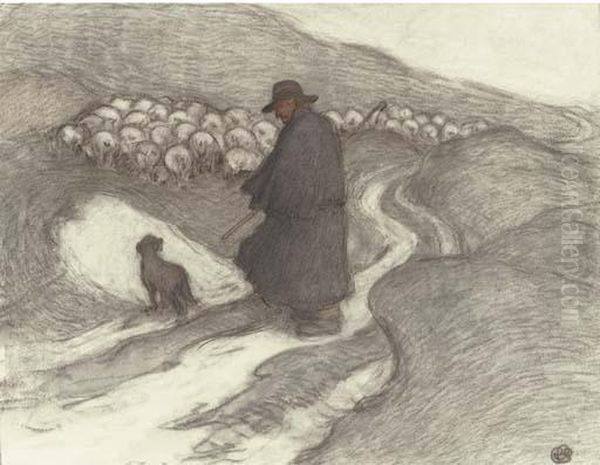
Robert Polhill Bevan's career represents a fascinating bridge between the 19th and 20th centuries, and between continental Europe and Britain. He absorbed the lessons of Gauguin, Cézanne, and Van Gogh, translating their innovations into a personal style suited to his chosen British subjects. As a founding member of the Camden Town Group and the London Group, he played an active role in the collective push towards modernism in London's art scene. His memorable depictions of horses, markets, and London streets, alongside his sensitive landscapes and accomplished lithographs, secure his legacy as a significant and distinctive voice in the story of modern British art. Though perhaps quieter than some of his contemporaries, his dedication to form, colour, and the honest portrayal of his environment marks him as a true pioneer.